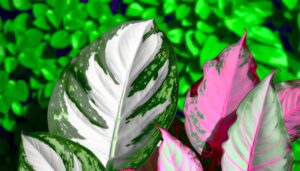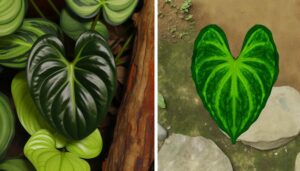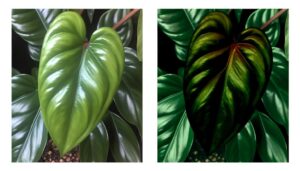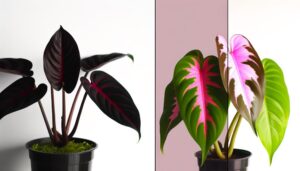Philodendron White Wave Vs Birkin
The Philodendron White Wave and Philodendron Birkin are celebrated for their unique variegation and ornamental appeal. White Wave exhibits a mosaic-like marbling of white and green, preferring bright, indirect light and regulated watering.
It matures to a compact 1-2 feet. In contrast, Birkin's dark green leaves feature linear white pinstripes and grow bushier but slightly taller.
Both require nutrient-rich, well-draining soil and are susceptible to pests like spider mites. They propagate well but need careful attention to preserve variegation.
For intricate growth patterns and care techniques, further exploration will provide deeper insights.
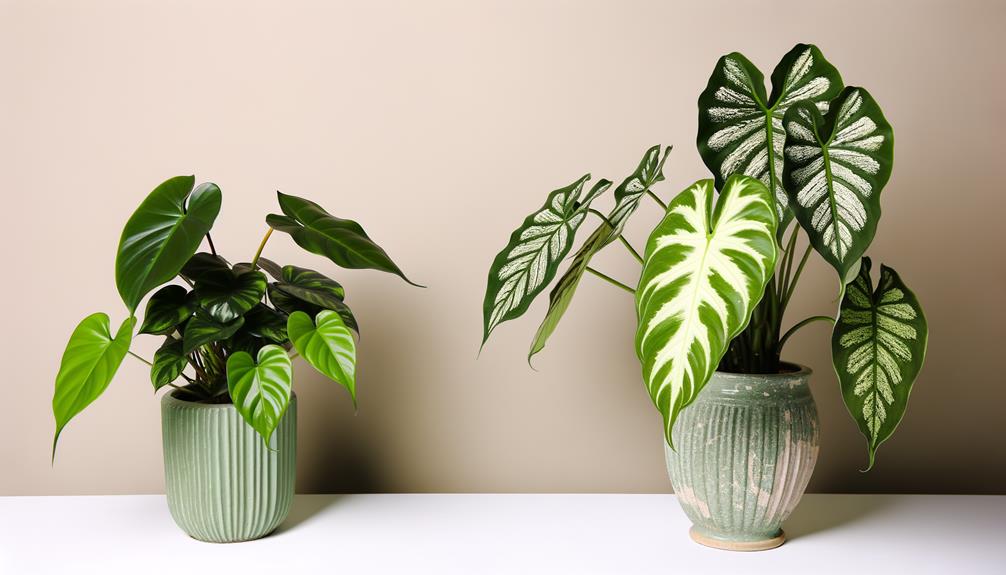
Key Takeaways
- Philodendron White Wave features a mix of white and green marbling, while Birkin showcases creamy-white pinstripes on dark green leaves.
- White Wave can cascade up to 3-4 feet, whereas Birkin maintains a compact, bushy form under 1-2 feet.
- White Wave thrives in bright, indirect light, while Birkin prefers moderate to bright indirect light.
- White Wave requires consistent watering, unlike Birkin, which prefers slightly drier conditions between waterings.
- Both species need nutrient-rich potting mixes with good drainage and a pH between 5.5 to 6.5.
Origin and History
The Philodendron White Wave and Philodendron Birkin, both members of the Araceae family, have distinct origins and histories that reflect their unique characteristics and cultivation backgrounds.
Philodendron White Wave, a cultivar of Philodendron erubescens, originates from the tropical rainforests of South America. It was selectively bred for its variegated foliage, enhancing its ornamental value.
Conversely, Philodendron Birkin is a relatively recent hybrid, derived through mutation and selective breeding from Philodendron Rojo Congo. This mutation gained popularity among horticulturists due to its striking variegation patterns.
Both plants have been cultivated extensively in controlled environments, ensuring their desirable traits are maintained. Understanding their origins provides insight into their adaptability and care requirements, which are pivotal for successful cultivation.
Appearance and Foliage
Philodendron White Wave and Philodendron Birkin exhibit distinct leaf color patterns. The White Wave is characterized by its variegated white and green foliage, while the Birkin displays striking white pinstripes on dark green leaves.
When it comes to growth and size, White Wave typically matures to a compact form with a maximum height of approximately 1-2 feet. In contrast, Birkin can reach a slightly larger stature under ideal conditions.
These differences in appearance and foliage not only contribute to their aesthetic appeal but also influence their care requirements and suitability for various indoor environments.
Leaf Color Patterns
When comparing leaf color patterns, Birkin exhibits striking variegation with creamy-white pinstripes against a dark green backdrop, while White Wave showcases a more uniform mix of white and green marbling.
The Birkin's leaves display a linear variegation pattern, where distinct, elongated streaks of white traverse the leaf surface, creating a dramatic contrast. Conversely, White Wave's leaves exhibit a mosaic-like pattern of variegation, with irregular patches of white and green interspersed throughout the foliage.
This marbled effect gives the White Wave a more blended and cohesive appearance. Both cultivars possess glossy, heart-shaped leaves, but the distribution and intensity of variegation in these philodendrons provide unique visual distinctions that are appealing to collectors and horticulturists alike.
Growth and Size
Both cultivars exhibit unique growth habits. Birkin typically achieves a more compact form, while White Wave tends to develop a slightly more expansive and cascading foliage structure.
Birkin, known for its bushy growth, rarely exceeds 1-2 feet in height. It is characterized by closely spaced nodes and upright, tightly packed leaves.
In contrast, White Wave can extend its vines up to 3-4 feet, displaying a more trailing habit. The internodal spacing in White Wave is greater, allowing for broader leaf spread and a more open canopy.
These differences in growth patterns notably influence their care requirements. Birkin favors confined spaces, while White Wave thrives in areas where its sprawling nature is accommodated.
Both cultivars demand well-draining soil and moderate humidity.
Growth Patterns
In examining the growth patterns of Philodendron White Wave and Birkin, notable distinctions emerge in leaf size, growth rate, and light requirements.
Philodendron White Wave tends to produce smaller, more compact leaves, whereas Birkin exhibits a propensity for larger, broader leaves.
Additionally, Birkin generally demonstrates a slower growth rate compared to White Wave, with both species' growth being notably influenced by their respective light exposure conditions.
Leaf Size Differences
Philodendron White Wave exhibits a more compact leaf structure, with leaves typically reaching a maximum length of 4 to 6 inches, contrasted by the Birkin's larger, more expansive foliage, which can grow up to 8 to 10 inches in length under ideal conditions.
The White Wave's leaves are characterized by their undulating margins and a more rigid, corrugated texture, providing a distinct tactile experience. In contrast, the Birkin's leaves possess a smoother, glossier surface with pronounced variegation, featuring creamy white pinstripes against a dark green background.
These morphological differences in leaf size and texture are indicative of their distinct genetic makeup and environmental adaptations, contributing to their unique aesthetic appeal and suitability for various indoor horticultural settings.
Growth Rate Comparison
While the morphological differences in leaf size and texture are evident, the growth rate and patterns of the White Wave and Birkin also exhibit significant variations reflective of their unique physiological processes and environmental adaptations.
Philodendron White Wave generally demonstrates a faster growth rate, attributable to its efficient nutrient uptake and robust photosynthetic capacity. This species often produces new foliage at a rapid pace, creating a lush, dense appearance.
Conversely, Philodendron Birkin exhibits a slower growth rate, characterized by more deliberate leaf development and expansion. This slower pace is often due to its variegated leaves, which contain less chlorophyll, hence reducing photosynthetic efficiency.
These growth patterns highlight the adaptive strategies each species employs within their respective ecological niches.
Light Requirements Impact
Best light conditions greatly influence the growth patterns of both the White Wave and Birkin philodendrons, with each species exhibiting distinct photophysiological responses.
The White Wave, known for its variegated foliage, thrives under medium to bright indirect light, enhancing chlorophyll production and variegation contrast. Conversely, the Birkin, characterized by its striped leaves, prefers bright indirect light to enhance its unique foliar patterns.
Insufficient light can lead to etiolation, where both species display elongated internodes and reduced leaf pigmentation. Excessive light exposure may cause photoinhibition, leading to chlorosis and potential tissue necrosis.
Hence, precise light management is critical to maintaining the aesthetic and physiological health of these philodendrons, ensuring robust growth and ideal leaf morphology.
Light Requirements
Best light conditions are crucial for the healthy growth of both Philodendron White Wave and Birkin, with each variety showing specific preferences for light intensity and duration. Philodendron White Wave thrives in bright, indirect light, needing filtered sunlight to maintain its variegated foliage. Conversely, Philodendron Birkin prefers moderate to bright indirect light, which enhances its distinctive striped leaves. Prolonged exposure to direct sunlight can cause leaf burn in both species, while insufficient light leads to leggy growth. Utilizing grow lights can supplement natural light during short winter days.
| Aspect | Philodendron White Wave | Philodendron Birkin |
|---|---|---|
| Ideal Light Type | Bright Indirect Light | Moderate to Bright Indirect |
| Sunlight Tolerance | Filtered Sunlight | Filtered Sunlight |
| Direct Sunlight Risks | Leaf Burn | Leaf Burn |
| Inadequate Light | Leggy Growth | Leggy Growth |
Understanding these specific light requirements is crucial for successful cultivation.
Watering Needs
Adequate watering practices are essential for maintaining the health and vigor of Philodendron White Wave and Birkin. Each plant has distinct hydration requirements that prevent root rot and promote ideal growth.
Philodendron White Wave thrives in consistently moist soil but is highly susceptible to waterlogging, requiring well-regulated watering intervals. On the other hand, Philodendron Birkin prefers slightly drier conditions and should only be watered when the top inch of soil feels dry to the touch.
Both species benefit from using room-temperature, dechlorinated water to avoid shocking the root system. It is necessary to adjust watering frequency based on seasonal variations, ensuring reduced watering during dormancy periods in winter when metabolic activities are minimal.
Proper drainage is vital to mitigate the risks of overwatering.
Soil Preferences
Philodendron White Wave and Birkin require well-ventilated, nutrient-rich potting mixes to support root health and growth. An ideal soil composition includes perlite, peat moss, and orchid bark for superior drainage and to prevent root rot. Adding organic matter like compost or worm castings enriches the substrate with necessary micronutrients.
Maintaining a pH range between 5.5 to 6.5 is crucial for optimal growth, as it creates a slightly acidic environment that enhances nutrient uptake. Incorporating materials such as activated charcoal can improve soil aeration and regulate excess moisture. Regularly assessing the soil's condition and replenishing its organic content is essential for sustained growth and vitality.
This care routine creates an ideal environment for Philodendron White Wave and Birkin to flourish.
Common Pests and Diseases
One of the prominent challenges in cultivating Philodendron White Wave and Birkin is managing infestations of pests such as spider mites, aphids, and mealybugs, which can severely compromise plant health. These pests can cause chlorosis, stunted growth, and even plant death if not promptly addressed.
Additionally, fungal infections like root rot, often induced by overwatering, can lead to wilting and decay. Effective strategies for mitigating these issues include:
- Regular Inspection: Frequently check for early signs of infestation or disease.
- Biological Control: Introduce natural predators like ladybugs to manage pest populations.
- Proper Watering Practices: Guarantee soil has good drainage to prevent fungal infections.
- Chemical Treatments: Utilize insecticidal soaps and fungicides as necessary.
Ease of Propagation
While managing pests and diseases is essential for maintaining plant health, understanding the ease of propagation for Philodendron White Wave and Birkin can greatly enhance their cultivation and promote robust growth.
Philodendron White Wave propagates efficiently through stem cuttings. Select a healthy stem with at least one node, ensuring ideal rooting conditions by placing it in a well-aerated substrate and maintaining high humidity levels.
Conversely, Philodendron Birkin, though also propagated via stem cuttings, requires meticulous care to preserve its variegated foliage. Employing a rooting hormone may expedite the process.
Both species benefit from indirect light and consistent moisture during propagation. Mastery of these techniques guarantees successful multiplication and sustains the aesthetic appeal of these popular houseplants.
Conclusion
In the grand botanical arena, Philodendron 'White Wave' and 'Birkin' duel with unparalleled finesse—each flaunting distinct variegation, light demands, and moisture affinity.
These verdant gladiators, though susceptible to common pests, demonstrate robust growth when pampered with specific soil and propagation protocols.
Choosing between them is akin to selecting the superior strand of DNA: a task best reserved for the discerning horticulturist armed with a loupe and an unyielding love for chlorophyll choreography.



